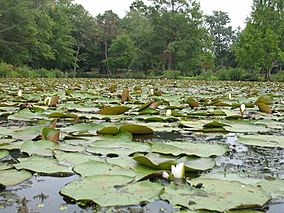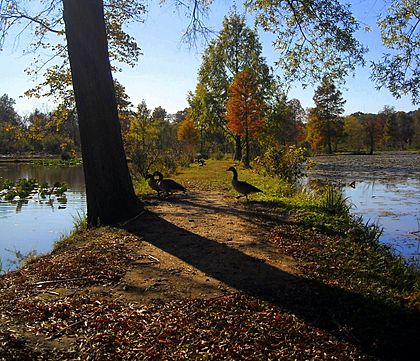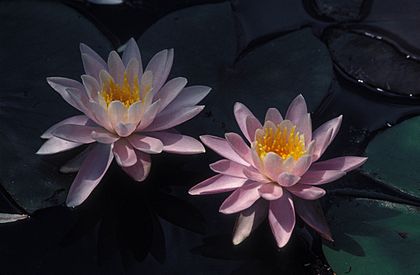Kenilworth Park and Aquatic Gardens facts for kids
Quick facts for kids Kenilworth Park and Aquatic Gardens |
|
|---|---|

Waterlilies in Kenilworth Park & Aquatic Gardens
|
|
| Lua error in Module:Location_map at line 420: attempt to index field 'wikibase' (a nil value). | |
| Location | District of Columbia, USA |
| Nearest city | Washington, D.C. |
| Area | about 700 acres (280 ha) |
| Established | 1938 |
| Governing body | National Park Service |
Kenilworth Park & Aquatic Gardens is a special place managed by the National Park Service. It is located in the northeastern part of Washington, D.C., close to the Maryland border. This park is found near the Anacostia River. It is famous for its beautiful ponds filled with rare waterlilies and lotuses.
The park also has the Kenilworth Marsh. This is the biggest tidal marsh left in Washington, D.C. A tidal marsh is a wetland area that is regularly flooded by ocean tides. Next to the marsh, there is a fun area for recreation.
Contents
Amazing Plants and Animals
This park is home to many different kinds of living things. These plants and animals used to live all over the area. But then, cities grew bigger and took over much of the land. In the marsh, you can find many amphibians, birds, fish, and insects. There are also lots of wildflowers and other plants.
Scientists from the Patuxent Wildlife Research Center counted the species here. They found 650 types of insects and 150 kinds of land plants. There were also 76 bird species and 18 fish species. They counted 9 types of mammals and 8 types of reptiles. Other living things like algae and mushrooms were also found.
The Audubon Society also counts birds every year. In 2007, they found 59 different bird species. Overall, 257 different types of birds have been seen in the park. These include herons, shorebirds, and sparrows. Some less common birds also visit.
Mammals living in the park include beavers, muskrats, and minks. You might also spot deer, foxes, and coyotes. Besides lilies, other wetland plants grow well here. These include wild rice and cattails. Unfortunately, some harmful plants and animals have also been found. For example, snakeheads are an invasive fish species in the ponds.
A Look at the Park's History

The land where Kenilworth Aquatic Gardens now sits was bought in the 1880s. A Civil War veteran named Walter B. Shaw bought it. He missed his home state of Maine. So, he had wild waterlilies from Maine brought here. He planted them on his new land.
The flowers grew very well in this new environment. Because of this, Shaw brought in more plants. In 1912, he opened a business called W.B. Shaw Lily Ponds. Many important people, including U.S. presidents, visited his gardens.
When Shaw passed away in 1921, his daughter took over. Her name was Helen Shaw Fowler. The business was doing very well. However, the nearby Anacostia River was becoming full of mud. This made it hard for boats to travel. The United States Army Corps of Engineers was called to clean the river. This work put the gardens in danger of being destroyed.
Helen worked hard to save the gardens. Finally, in 1938, the U.S. Congress agreed to buy the gardens. They paid $15,000 to create the park we know today.
Later, in 1942, the area south of the gardens was used differently. The local government decided to use it as a place to dispose of trash. Trash was burned in open piles there. This area, known as the Kenilworth Dump, was closed in the 1970s. The land needed a lot of cleaning up after that. Because of this, a walking trail called the Anacostia Riverwalk Trail was built around this area for a while.
Kenilworth Park Today
Today, the National Park Service manages Kenilworth Park. It is part of the National Capital Parks-East system. The park covers about 700 acres (2.8 km2). It includes the beautiful water gardens, Kenilworth Marsh, and areas for sports and fun.
The gardens are now listed on the National Register of Historic Places. This means they are recognized as an important historical site. They are also a special landmark for the nation's capital. Parts of Kenilworth Marsh were also restored between 1992 and 1993. This added 32 acres (130,000 m2) of new tidal marsh where there used to be just mud.
Images for kids
-
Waterlilies in Kenilworth Park & Aquatic Gardens
-
Canada geese crossing a path in the Kenilworth Park and Aquatic Gardens





